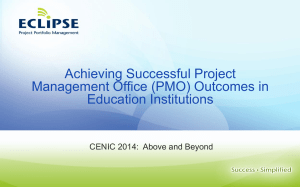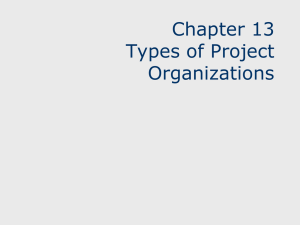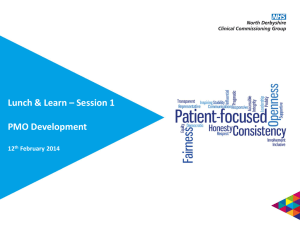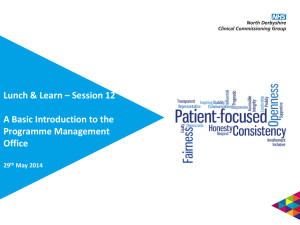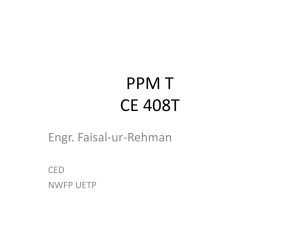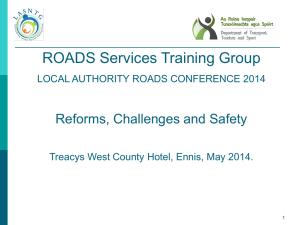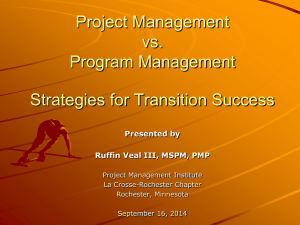19th February 2014 - North Derbyshire CCG
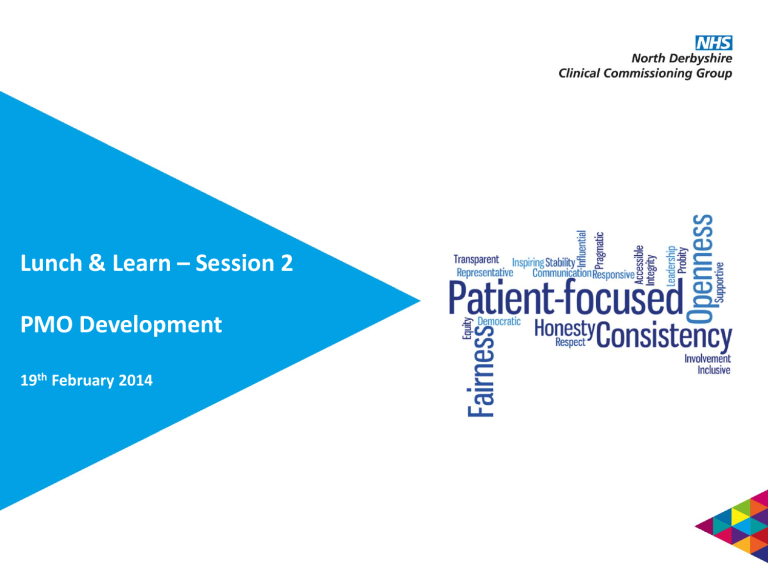
Lunch & Learn – Session 2
PMO Development
19 th February 2014
Lunch & Learn – Session 2
Aim: To develop the PMO processes with you.
Previously….on Lunch & Learn #1:
• Keep it Simple
• Keep it Proportionate
• Remove the Bureaucracy
Feedback
• “I really value the introduction of the PMO, I think it will help Programme Leads manage and prioritise their work and help us to know what is expected and when”
Head Of Planned Care
Lunch & Learn – Session 2
By 2.00PM
Part 1
• overview of PMO
• The story so far
• What is a PMO
• Ideas to Projects – a high level process
Part 2 - flexible
• What do you need from a PMO?
• What does a PMO need from you?
Lunch & Learn – Session 2
What do you want from this Lunch & Learn?
(apart from cake)
PMO – was it good for you?
PMO – The Story so Far
1) NHS England – 2 Year Operational & 5 Year Strategic Plan from each CCG
• Programme Leads presented first draft Dec 2013
• Draft 5 Year plan Jan 2014
• Draft 2 Operational Plan Feb 2014
• Final Operational plan Apr 2014
• Final Strategic Plan Jun 2014
2) CCG recognise the need for structured planning, prioritising, monitoring and reporting
5 Year Strategic Plan – NDCCG Plan on a Page
1
DERBYSHIRE SYSTEM VISION
Derbyshire health and social care economy is a system comprised of partners from Erewash, Hardwick, North and Southern CCGs, Derbyshire County Council and all Provider Trusts within the Derbyshire borders. Our common vision focuses on achieving a seamless health and social care service; at an individual level we have adopted the vision from National Voices: ‘I can plan my care with people who work together to understand me and my carer (s), allowing me control and bringing together services to achieve the outcomes important to me’.
North Derbyshire CCG supports this with their vision:
‘Work together across health, social care, housing, voluntary sector and with the public itself to enable people to retain independence supported by their local community. When publicly funded services are required they will be responsive, safe, caring and provide a good experience of care still within the local community in the majority of cases. Where exceptionally people need to access more specialised services outside of their community this will happen easily and they will be supported to return to their local community as quickly as possible’.
4 Delivered through the following improvement interventions:
5
Overseen through the following governance arrangements:
2
Strategic Aim One
Transform Primary Care
Strategic Aim Two
1.
Description of the improvement intervention required to deliver the desired state
2.
outlined in the vision section above
3.
Ensure seamless 24/7 access to primary care
4.
Introduce a shared clinical record across all primary care medical care providers
5.
Implement Flo telehealth system
1.
Develop integrated community services for the frail elderly
2.
Develop an integrated behaviour pathway for children and young people
Existing system wide structures: o Adult Care Board o Health and Well Being Board o Joint Commissioning Co-ordinating Group o 21 st
Century Transformation Programme Board
Internal governance structure support by Programme
Management Office
Develop integrated models of care (with a focus on frail and elderly, children’s and young people and mental health pathways)
3.
Introduce new commissioning arrangements for children’s continuing care
4.
Review of children’s services mapping, cost and value to enable outcomes based commissioning
5.
Develop primary care based dementia services
6.
Implement RAID psychiatric liaison service
7.
Transform the care pathway for patients with learning disabilities moving to a more integrated, community based service
3
Measured using the following success criteria:
The health and wellbeing of the North Derbyshire population will be maximised
Inequalities and unwarranted clinical variation will be reduced
People will increasingly be enabled to retain their independence with the support of their local community and through integrated
Strategic Aim Three care teams provided in the community
Services, when required, will be responsive, safe, caring and
Redesign urgent and emergency
1.
Offer assessment, treatment and care in the community as an alternative to travel to hospital
2.
Optimise emergency patient pathway flow through CRH – ED, CDU, EMU and wards care
Strategic Aim Four
3.
Improve discharge planning and post acute pathway
1.
Review and recommission new integrated diabetes pathways for type 1 and 2 patients provide a good experience of care
All organisations within the health economy will meet their financial targets year on year.
No provider will be under enhanced regulatory scrutiny due to performance concerns
Improve the management of 2.
Review the current model provision/services for patients with COPD
3.
Develop the Hospice at Home model supporting patients to die at home.
Achievement of the improving outcomes ambitions will be used as long term conditions the key set of measures to determine whether the above criteria
Strategic Aim Five
Focus on prevention/
1.
Continue to work with Public Health on a range of measures related to prevention and early diagnosis
2.
Review and adopt the recommendations (as appropriate) of the prevention review commissioned from Public Health have been met. self management
Strategic Aim Six
Review the productivity of elective care
1.
Commission a deep dive analysis on a number of elective care pathways commencing with
Neurological conditions and MSK
2.
Analyse and benchmark CCG performance on a range of elective care metrics such as conversion rates, day surgery rates and new to follow up ratios
3.
Work with the Clinical Strategic Networks to identify specialised services which necessitate concentration in centres of excellence
6
System values and principles
All services will be commissioned in accordance with the publically consulted on system wide guiding principles for service change and the CCG’s values:
Patient Focus
Integrity
Courage
Responsiveness
Why do we need a PMO?
• Where do I get a decision on this project?
• What information do I need to get this proposal considered?
• Which meeting does my proposal need to go to?
• Who should I report progress to? When? How? Why?
• Who do I speak to, to change the scope of my project?
• Is there any funding available for a new change project?
• How does my project relate to other projects/programmes?
• The PMO will help to put in place the process to answer these questions
Why do we need a PMO?
• Operational : To ensure the CCG delivers its plan and fundamentally improves services for patients.
• Strategic/Transformational :
– the CCG will need to transform health services in North Derbyshire. This will only be delivered if we have a clear roadmap of how to get there and ensure we deliver against this.
– The CCG will also need to ensure sustainability of its providers or if sustainability is not desirable drive the commissioning of alternative models.
Why do we need a PMO?
• Financial :
– Comprehensive Spending Review – funding increases will not cover demand and inflation in future years and the CCG will need to make some difficult decisions about where to invest (and disinvest).
– QIPP is not delivering year to date – will be critical in future years to deliver financial balance and maintain authorisation.
390 000
385 000
380 000
375 000
370 000
365 000
360 000
355 000
Year 1 Gap: £9m
Year 2 Gap: £14.1m
Forecast Spend
Resources Available
2013/14 2014/15 2015/16
PMO - People
• Jo Ross, Brian Nevin, Jo Gregory
• Amy Miles, Evelyn Koon
• Shofiq Rahman, Aaron Gillott
• GEM - Ian Rosser, Helen Short, Obrad Sudar
One to One / Meeting - Any time, by request
What is a PMO?
Detailed
Plans
Programme
Management
Office
Risk
Management
Benefit
Tracking
The PMO provides
•
•
•
•
•
•
Programme support
Programme/project development; sufficiently robust to provide best chance of success during implementation; rigorously detailed to allow measurement and to track progress; ensure appropriate tools, templates and processes are used and followed; implemented within the planned time limit and with the intended outcomes (i.e. milestones and KPI’s are met); provide project managers with support, advice and signposting to additional expertise for their projects
Monitoring and Measurement function
Co-ordination, Review and Scrutiny of key projects
What isn’t a PMO?
Detailed
Plans
Programme
Management
Office
Risk
Management
Benefit
Tracking
A PMO is NOT a function that takes control over the projects from Programme Leads
It oversees and monitors delivery, it doesn’t
do or deliver the projects themselves!
What are the benefits of our PMO?
The PMO will help you to:
• Demonstrate that we are delivering tangible improvements in service/patient care and shout about our successes!
• Provide assurance to the Governing Body that implementation of our plans is progressing and delivering the intended benefits.
• Identify what work/projects are priority and focus resource accordingly
• Enable any barriers to progress/issues to be resolved quickly
• Facilitate more effective and quicker decision making .
• Develop excellent project management capabilities that will ensure we are an effective and slick organisation.
DRAFT PMO Governance Structure
Governing Body
Gov. Body Assurance
Committee
PMO SUPPORT:
Provides assurance in the form of a monthly highlight report including exceptional progress and exceptions they can assist to progress
Planning Delivery
Group
Purpose:
Oversees/monitors and ensures delivery of the
CCG Plan
Clinically led Programme
Groups, i.e.:
• Urgent Care Working Group
• Integrated Care project group
• Primary care
• Children, maternity and young people
• Long Term Conditions/Planned
Care groups
• Mental Health and LD
• Medicines Management
• Identifies key decisions to be made
• Highlights issues that the Group can assist in resolving
• Coordinates the agenda and produces highlight report (by exception).
• Assist in expediting/unblocking barriers to progress
• Project resource is deployed where required to bring projects back on track
• Works with programme leads to ensure all project documentation is in place
• Status reports are provided monthly
PMO Structure
•
•
•
•
•
Notes:
• Clinically led programmes will continue to report via their existing governance processes. Links into PMO therefore shown as a dotted line here.
• Multi-stakeholder/disciplinary groups will be supported by an Executive Sponsor,
Clinical and Programme Manager. They provide the top-level vision and support to the Programme Manager to drive the change by: advocating the case for change to strategic stakeholders, enabling delivery of the programme plan, assisting resolution of major issues, encouraging progress, and ultimately ensuring delivery of benefits.
Authorization of Projects - 1
NO
Process for Development & Implementation of Change Projects
ACTION
Identify Need
Generate & prioritize ideas
Draft project Proposal and identify priority level
RESPONSIBILITIES
Locality / Programme
Locality / Programme
Locality / Programme / PMO
TIMELINE
Week 1
Week 2
Week 2
Locality / Programme / PMO Week 2 Submit To Authorising Group*
Prioiritization Reviewed and
Agreed
Decision to proceed
YES
Authorising Group*
Authorising Group*
Week 3
Week 3
Authorization of Projects - 2
NO
Process for Development & Implementation of Change Projects - page 2
RESPONSIBILITIES TIMELINE ACTION
Refine project Proposal into
Project Planning Document
Submit to Authorising Group*
Decision to Proceed
YES
Implementation project performance and outcome monitoring
Locality / Programme / PMO
Locality / Programme / PMO
Authorising Group*
Locality / Programme / PMO
PMO
Week 4-7
Week 8
Week 8
Project Proposal
• Purpose: justify the release of resources to work up this proposal into a project
Project Planning Document
• Purpose: set out how and when the project’s aims and objectives are to be achieved. It will define the approach to be used by the
Project team and provides details of the execution , management and control of the project to include costs, milestones, activities and resources
End of Part One
What does it mean for your role/team?
What sort of work underway/planned in your team will be affected by the PMO process?
minimum information 1
1. What issue is my project addressing?
2. What is the project setting out to do?
3. What is the plan to get there - 5/6 milestones?
4. How will I measure success – quality/activity?
5. What resources will I need – people / finance?
minimum information 2
6. How will I manage and govern the project?
7. What issues am I aware of?
8. What are the most significant 5-10 risks to the project?
9. Is our success dependant on anything else (and if so, what)?
Lunch & Learn – Session 2
Next Steps:
Programme Leads - Answer the 9 questions by
Feb 28
th
Produce a Project Planning Document by March
31st
Lunch & Learn – Session 2
Tuesday 4th March
Next Lunch & Learns
Back to Basics:
For staff looking to refresh your project management skills
Wednesday 12th March Crunchy Numbers:
Measuring the success of your project is critical in ‘knowing how you are doing’. This session will help you in developing outcomes and how to measure impact
Wednesday 19 th March
Wednesday 26 th March
The Future
Understanding the PMO reporting cycle
Last Chance Saloon:
Open space for questions, specific project support and development
TBC A Basic Introduction to PMO – for anyone to attend
Lunch & Learn – Session 2
Thank you
Please Evaluate now
Alternative options
North Derbyshire CCG - Project Proposal Prioritisation Tool
1.
Does the Proposal contribute to the CCG’s vision and aims OR is it nationally mandated?
2.
Is there good evidence supporting the reason for the change?
1
3.
Can the impact of the change be measured?
NO
YES
Rate of
Return now
High priority
Will it deliver savings?
Rate of return
< 2 years
High priority
Rate of return
> 2 years
Medium priority
Rate of return now
High priority
Is the proposal cost neutral?
Rate of return
< 2 years
Medium priority
Rate of
Return
> 2 years
Low priority
DO NOT PROCEED
Will the proposal cost money?
Cost
< 100k
Medium priority
Cost
100k >
< 500k
Low priority
Cost
> 500k
Low priority
Procurement route via F&R
Consider the following questions and answer yes or no
1.
Does the proposal have an impact on health inequalities
2.
Will the proposal improve health outcomes
BOTH YES
Increase priority level by one
ONE YES
Maintain original priority level
N0 YES
Reduce priority level by one
Notes 1. Use Atlas of Variation or equivalent
PMO Reporting Cycle
Day 3 Programme Leads submit Highlight report – summarising project and programme progress to the end of the calendar month
Day 5
Day 10
Day 11
2 nd
Tuesday?
CCG Programme Pack collated
Month End Finance & Activity available - TBC
Finance & Activity information added to Highlight Report
Pack submitted to Planning Delivery Group (2 nd SMT of the month) for confirmation
PDG Progress report created
NB – if PDG meeting is before the Finance/Activity info is available, then the info is added after the PDG
3 rd
Monday?
PDG Progress report submitted to ?FRC equivalent - TBC?
(3 rd week of the month)
NB – papers for this may need to be submitted 1 week before
